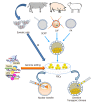Perspectives of pluripotent stem cells in livestock
- PMID: 33584977
- PMCID: PMC7859985
- DOI: 10.4252/wjsc.v13.i1.1
Perspectives of pluripotent stem cells in livestock
Abstract
The recent progress in derivation of pluripotent stem cells (PSCs) from farm animals opens new approaches not only for reproduction, genetic engineering, treatment and conservation of these species, but also for screening novel drugs for their efficacy and toxicity, and modelling of human diseases. Initial attempts to derive PSCs from the inner cell mass of blastocyst stages in farm animals were largely unsuccessful as either the cells survived for only a few passages, or lost their cellular potency; indicating that the protocols which allowed the derivation of murine or human embryonic stem (ES) cells were not sufficient to support the maintenance of ES cells from farm animals. This scenario changed by the innovation of induced pluripotency and by the development of the 3 inhibitor culture conditions to support naïve pluripotency in ES cells from livestock species. However, the long-term culture of livestock PSCs while maintaining the full pluripotency is still challenging, and requires further refinements. Here, we review the current achievements in the derivation of PSCs from farm animals, and discuss the potential application areas.
Keywords: Cell-therapy; Cellular reprogramming; Chimera; Livestock; Ontogenesis; Pluripotency.
©The Author(s) 2021. Published by Baishideng Publishing Group Inc. All rights reserved.
Conflict of interest statement
Conflict-of-interest statement: The authors declare that there is no conflict of interest.
Figures




Similar articles
-
Mechanisms of Embryonic Stem Cell Pluripotency Maintenance and Their Application in Livestock and Poultry Breeding.Animals (Basel). 2024 Jun 9;14(12):1742. doi: 10.3390/ani14121742. Animals (Basel). 2024. PMID: 38929361 Free PMC article. Review.
-
Derivation of novel human ground state naive pluripotent stem cells.Nature. 2013 Dec 12;504(7479):282-6. doi: 10.1038/nature12745. Epub 2013 Oct 30. Nature. 2013. PMID: 24172903
-
Pluripotent Stem Cells for Livestock Health and Production.Curr Stem Cell Res Ther. 2022;17(3):252-266. doi: 10.2174/1574888X16666210803162019. Curr Stem Cell Res Ther. 2022. PMID: 34344296 Review.
-
Pluripotent stem cells and livestock genetic engineering.Transgenic Res. 2016 Jun;25(3):289-306. doi: 10.1007/s11248-016-9929-5. Epub 2016 Feb 19. Transgenic Res. 2016. PMID: 26894405 Free PMC article. Review.
-
Resetting Human Naïve Pluripotency.Genet Epigenet. 2016 Aug 4;8:37-41. doi: 10.4137/GEG.S38093. eCollection 2016. Genet Epigenet. 2016. PMID: 27512340 Free PMC article. Review.
Cited by
-
Exploring the promising potential of induced pluripotent stem cells in cancer research and therapy.Mol Cancer. 2023 Nov 28;22(1):189. doi: 10.1186/s12943-023-01873-0. Mol Cancer. 2023. PMID: 38017433 Free PMC article. Review.
-
Towards human organ generation using interspecies blastocyst complementation: Challenges and perspectives for therapy.Front Cell Dev Biol. 2023 Jan 19;11:1070560. doi: 10.3389/fcell.2023.1070560. eCollection 2023. Front Cell Dev Biol. 2023. PMID: 36743411 Free PMC article. Review.
-
How genome editing changed the world of large animal research.Front Genome Ed. 2023 Oct 11;5:1272687. doi: 10.3389/fgeed.2023.1272687. eCollection 2023. Front Genome Ed. 2023. PMID: 37886655 Free PMC article. Review.
-
Mechanisms of Embryonic Stem Cell Pluripotency Maintenance and Their Application in Livestock and Poultry Breeding.Animals (Basel). 2024 Jun 9;14(12):1742. doi: 10.3390/ani14121742. Animals (Basel). 2024. PMID: 38929361 Free PMC article. Review.
-
iPSC Technology: An Innovative Tool for Developing Clean Meat, Livestock, and Frozen Ark.Animals (Basel). 2022 Nov 17;12(22):3187. doi: 10.3390/ani12223187. Animals (Basel). 2022. PMID: 36428414 Free PMC article. Review.
References
-
- Evans MJ, Kaufman MH. Establishment in culture of pluripotential cells from mouse embryos. Nature. 1981;292:154–156. - PubMed
-
- Nishikawa S, Jakt LM, Era T. Embryonic stem-cell culture as a tool for developmental cell biology. Nat Rev Mol Cell Biol. 2007;8:502–507. - PubMed
-
- Wu J, Platero-Luengo A, Sakurai M, Sugawara A, Gil MA, Yamauchi T, Suzuki K, Bogliotti YS, Cuello C, Morales Valencia M, Okumura D, Luo J, Vilariño M, Parrilla I, Soto DA, Martinez CA, Hishida T, Sánchez-Bautista S, Martinez-Martinez ML, Wang H, Nohalez A, Aizawa E, Martinez-Redondo P, Ocampo A, Reddy P, Roca J, Maga EA, Esteban CR, Berggren WT, Nuñez Delicado E, Lajara J, Guillen I, Guillen P, Campistol JM, Martinez EA, Ross PJ, Izpisua Belmonte JC. Interspecies Chimerism with Mammalian Pluripotent Stem Cells. Cell 2017; 168: 473-486. :e15. - PMC - PubMed
Publication types
LinkOut - more resources
Full Text Sources
Other Literature Sources

